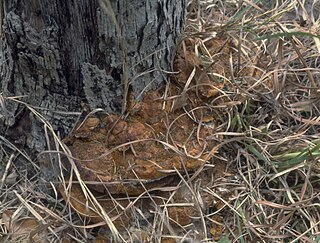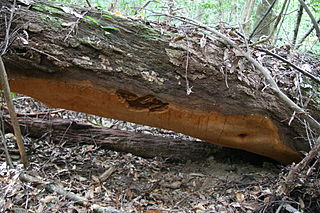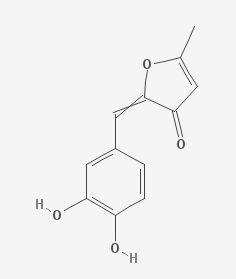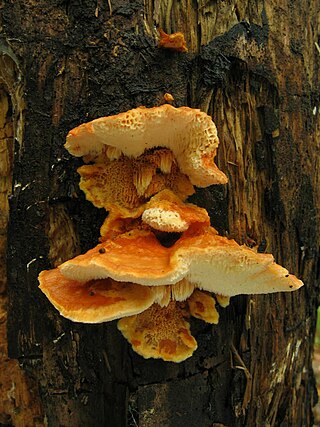
The Hymenochaetales are an order of fungi in the class Agaricomycetes. The order in its current sense is based on molecular research and not on any unifying morphological characteristics. According to one 2008 estimate, the Hymenochaetales contain around 600 species worldwide, mostly corticioid fungi and poroid fungi, but also including several clavarioid fungi and agarics. Species of economic importance include wood decay fungi in the genera Phellinus and Inonotus sensu lato, some of which may cause losses in forestry. Therapeutic properties are claimed for Inonotus obliquus ("chaga") and Phellinus linteus, both of which are now commercially marketed.

Phellinus gilvus is a fungal plant pathogen which infects several hosts. In traditional Chinese medicine, it is known as sanghuang and is used to treat stomachaches and cancer; polysaccharides isolated from lab-grown P. gilvus have been shown to inhibit the growth of melanoma in a mouse model.

Phellinus noxius is a plant pathogen. It attacks a wide range of tropical plants, and is the cause of brown root rot disease. It was described as "an aggressive and destructive pathogen". The pathogen invades roots with contact between roots of a potential host with the substrate on which the fungus is growing.

Phellinus weirii is a species of fungus. It is the plant pathogen that causes laminated root rot in certain conifers, typically Douglas-fir and western redcedar. It is widespread in the Douglas-fir growing regions of British Columbia, Washington and Oregon.

Phellinus pomaceus is a plant pathogen particularly common on Prunus species. It is not aggressively pathogenic but can cause considerable decay in trees suffering from other stress factors.

Meshimakobu and sanghuang / sanghwang, also known as mesima (English) or black hoof mushroom, is a mushroom in East Asia.

Phellinus igniarius is a fungus of the family Hymenochaetaceae. Like other members of the genus of Phellinus it lives by saprotrophic nutrition, in which the lignin and cellulose of a host tree is degraded and is a cause of white rot. Common names are willow bracket and fire sponge.

Phellinus is a genus of fungi in the family Hymenochaetaceae. Many species cause white rot. Fruit bodies, which are found growing on wood, are resupinate, sessile, and perennial. The flesh is tough and woody or cork-like, and brown in color. Clamp connections are absent, and the skeletal hyphae are yellowish-brown.

Hispidin is a natural substance. It can also be synthesized.

Phellinus ellipsoideus is a species of polypore fungus in the family Hymenochaetaceae, a specimen of which produced the largest fungal fruit body ever recorded. Found in China, the fruit bodies produced by the species are brown, woody basidiocarps that grow on dead wood, where the fungus feeds as a saprotroph. The basidiocarps are perennial, allowing them to grow very large under favourable circumstances. They are resupinate, measuring 30 centimetres (12 in) or more in length, though typically extending less than a centimetre from the surface of the wood. P. ellipsoideus produces distinct ellipsoidal spores, after which it is named, and unusual setae. These two features allow it to be readily differentiated microscopically from other, similar species. Chemical compounds isolated from the species include several steroidal compounds. These may have pharmacological applications, but further research is needed.
Phellinus sulphurascens is the Douglas-fir species of the fungus genus, Phellinus. It was recently recognized as a distinct species from Phellinus weirii. Both were historically thought to be the same, but genetic tests suggested that the two species were distinct. The form first described as P. weirii is the cedar form.

Hispolon is a bio-active isolate of Phellinus linteus.

Hypholomine B is a neuraminidase inhibitor isolated from the fungus Phellinus linteus.

Inotilone is a chemical compound isolated from Phellinus linteus.
Aspen trunk rot is a fungal disease that causes stem decay heart rot of living aspen trees. The pathogen that causes this disease is the fungus Phellinus tremulae. Most of the symptoms of this disease are internal, with the only external signs of a diseased aspen being fruiting bodies called conks. A single conk found on an aspen can indicate advanced decay of up 82% of the tree volume. Internal decayed wood of freshly cut aspens is spongy, yellow/white colored, surrounded by black zones of discoloration, and contains a distinct wintergreen smell. The fungus is spread via airborne spores released from the fruiting body which can infect through dead branches, branch stubs, or wounds in the tree. Although no direct management control is known, harvesting aspen stands that have been damaged or harvesting stands before decay becomes advanced minimizes tree loss. Aspen wood is white, malleable but strong, and heat-tolerant and therefore has many commercial uses including matches, packing paper, lumber, plywood, pulp, and animal beds. Aspen trees diseased with aspen trunk rot decrease the economic value of the lumber.
Tropicoporus tropicalis is a mushroom of the family Hymenochaetaceae. Tropicoporus tropicalis is a wood-decaying basidiomycetes that rarely causes disease in animals and human, and is commonly found in humid climate such as Brazil. In its natural environment, the fungus is associated with white rot woody angiosperms, and has its annual fruiting body on tree trunks and branches. Tropicoporus tropicalis has two kinds of hyphae, generative and skeletal, that lack clamp connections.

In Finland, Kotiranta and Niemelä introduced a widely used method for comparing the conservation values of different forest areas, based on the observation that certain wood-rotting fungi are very sensitive to the impact of human activities on forest ecosystems. Such species are slow to return to areas from where they have disappeared, so their presence is evidence of a long continuity in forest ecosystems.

Phellinus robiniae, commonly called the cracked cap polypore or Phellinus rimosus, is a fungus of the family of Hymenochaetaceae. The fungus primarily infests black locusts, aided by openings caused by Megacyllene robiniae infestation, but also grows on various other trees such as Carya, oak, and Acacia. Cracked cap polypore is sympatric with most of its hosts. It has a brown spore print, leaving brown streaks on the tree below the fungus.
Cyperus lundellii is a species of sedge that is native to parts of southern parts of North America and parts of Central America.














